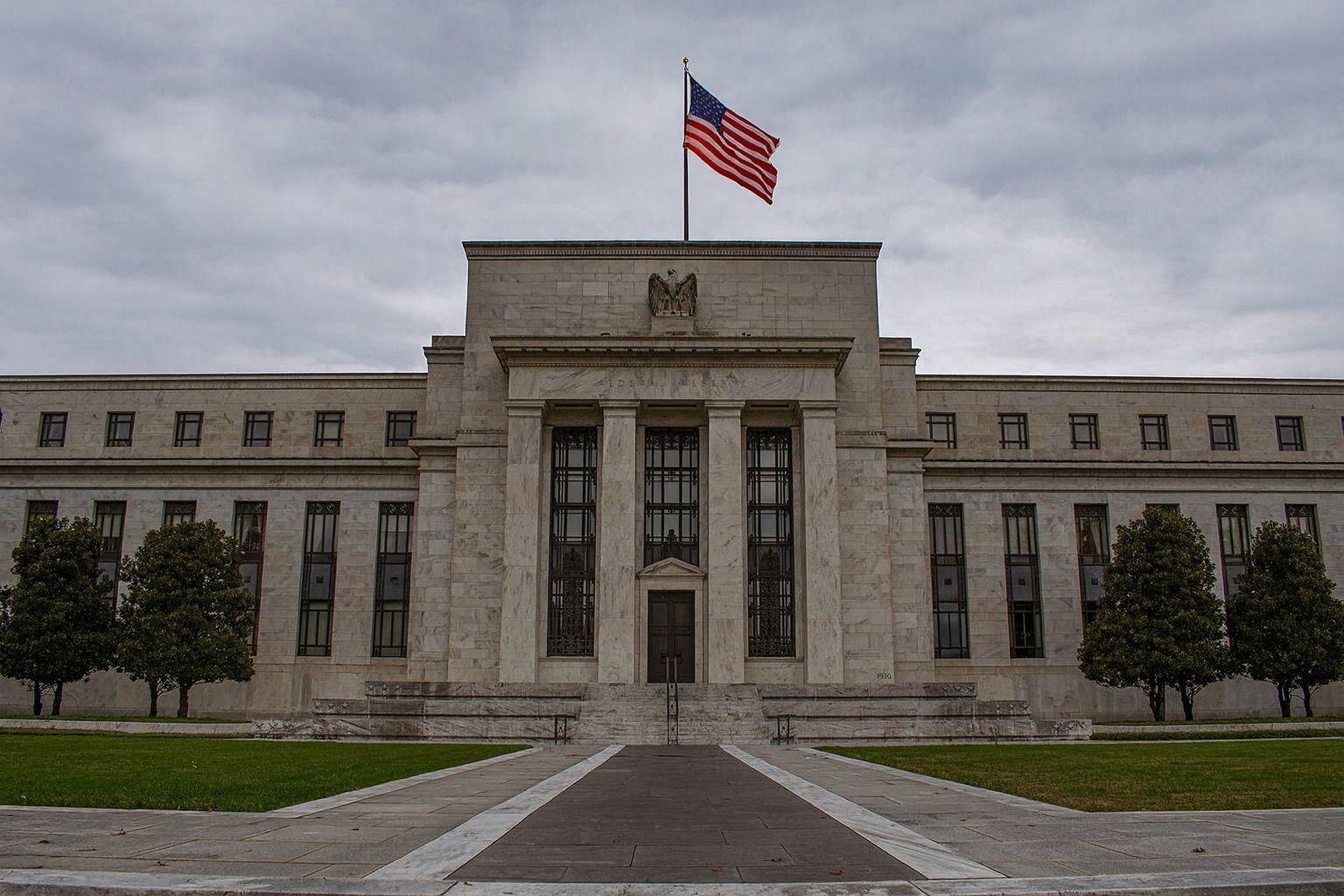- Fed delivers rate cut: On October 29, the Federal Reserve lowered its benchmark interest rate by 0.25%, setting the federal funds target range to 3.75–4.00% – the second cut this year [1].
- Flying blind: A weeks-long federal government shutdown has created a “data drought,” leaving the Fed operating “in a fog” with key economic reports (like jobs and inflation) delayed [2] [3]. Even so, policymakers stuck to their signaled path of rate reductions to bolster growth and hiring.
- Market euphoria: U.S. stocks have surged to record highs ahead of the Fed’s move. This week the S&P 500 and Nasdaq jumped to all-time peaks, fueled by big-tech and AI-driven rallies [4]. As one trader put it, “the bulls remain fully in charge,” with nothing yet shaking investors’ upbeat sentiment [5].
- Economic cracks showing: Fed Chair Jerome Powell has cautioned that the labor market is “somewhat softer,” with “downside risks to employment” rising [6]. Some officials – like Governor Christopher Waller – argue rates should be cut more aggressively to cushion the slowdown [7], even as a few hawks worry about inflation.
- Outlook: Analysts see another Fed rate cut in December as highly likely (futures put the odds >90%) [8]. Many expect easier monetary policy and strong tech earnings to keep lifting stocks into year-end [9]. However, mortgage rates remain stubbornly high around ~6.2% and may not fall much further soon [10], indicating limited relief for homebuyers despite the Fed’s pivot.
Fed Cuts Rates Despite Missing Data
The Federal Open Market Committee’s October 28–29 meeting concluded with a widely anticipated quarter-point rate cut, bringing the target interest rate down to roughly 3.8% [11]. Economists were nearly unanimous in predicting this move [12], as the Fed had telegraphed an easing bias in advance. It marks the second reduction in 2025, following an initial cut in September. The Fed is proceeding with caution, however. Officials describe an “increasingly cloudy” economic outlook [13] – a haze compounded by the absence of government data during the ongoing shutdown. Since October 1, key indicators like the monthly jobs report and inflation readings have been delayed or canceled, depriving policymakers of their usual guides [14] [15]. Despite “flying blind” to some extent, the Fed opted to stick with its plan to ease policy in October, having judged at its September meeting that gradual rate cuts were likely needed in both October and December [16]. The idea is that interest rates, which stood around 4.1% before this meeting, were high enough to be restraining economic growth, giving the Fed room to trim borrowing costs without stoking inflation [17] [18].
Fed Chair Jerome Powell and colleagues have emphasized that inflation, while still above the 2% goal, has been coming in slower than expected – roughly a 3% year-over-year pace recently [19]. “Inflation remains elevated but isn’t accelerating,” one report noted, suggesting no need for further rate hikes [20]. At the same time, the U.S. labor market has clearly lost momentum: job gains averaged only ~29,000 per month over the summer, a drastic slowdown from ~100,000 per month before the pandemic [21]. Powell warned in September that in this “softer” labor market, “the downside risks to employment appear to have risen” [22]. In other words, the Fed is growing more concerned about a weakening job market than about runaway prices. This backdrop of moderating inflation and cooling employment bolstered the case for easing. “Imagine you’re driving in a winter storm and suddenly lose visibility… While you slow the car down, you’re going to continue going in the direction you were going,” explained economist Kris Dawsey, illustrating why the Fed would continue on its pre-set course of rate cuts despite the data blackout [23].
To mitigate risks, Fed officials say they’ve been turning to alternative data and anecdotal evidence in lieu of official reports [24] [25]. For instance, weekly unemployment claims and private payroll surveys are still available, and the Fed’s regional business contacts provide on-the-ground insights [26]. These sources suggest the economy may be weaker than the last government numbers indicated – consistent with the Fed’s decision to deliver support. “The government shutdown has…left the central bank in a fog about the labor market, fueling support for another cut rather than risk falling behind,” observed Ryan Sweet, chief U.S. economist at Oxford Economics [27]. If the data blackout persists, “discretion will remain a factor in December and… the longer the government shutdown drags on, the higher the odds of another rate cut,” Sweet added [28]. In essence, lacking fresh data, policymakers prefer to err on the side of more stimulus now, rather than be caught too late if the economy slips.
Notably, the Fed also inched toward ending its balance sheet runoff (quantitative tightening). Officials have hinted that they may soon stop shrinking the Fed’s $6½ trillion bond portfolio to avoid stressing financial markets [29] [30]. Such a step – potentially announced alongside the rate decision – would be aimed at keeping long-term interest rates and bank funding conditions stable. It underscores the Fed’s more accommodative turn: not only cutting rates, but also ensuring liquidity remains ample.
Wall Street Hits Record Highs on Rate Optimism
Investors had been celebrating the prospect of easier Fed policy for weeks, and that optimism only grew heading into the October decision. In fact, U.S. equity markets soared to new records even before the Fed’s announcement. On Monday, October 27, the S&P 500 index closed around 6,875 and the Nasdaq Composite near 23,637 – each a historic peak [31]. By the next day, both indices notched yet another record (S&P ~6,891; Nasdaq ~23,827) [32]. The rally has been broad-based but led by the tech sector, which tends to benefit from lower interest rates. High‑growth technology and “Magnificent Seven” mega-cap stocks powered much of the advance. For example, chipmaker Nvidia’s stock surged 5% and Microsoft’s climbed 2% ahead of the Fed meeting [33]. All five Big Tech giants reporting earnings this week (Apple, Microsoft, Alphabet/Google, Amazon, and Meta) saw their shares rise going into the decision [34], reflecting bullish sentiment. Even traditionally staid sectors joined the upswing – major bank stocks jumped 4–5% after strong Q3 earnings [35] – signaling that the risk-on mood is widespread.
Multiple factors are feeding the market euphoria. Key inflation data has been tame, trade tensions with China showed signs of easing (President Trump hinted at progress on a U.S.–China trade deal) [36], and the Fed’s dovish tilt suggests lower borrowing costs ahead. Benchmark Treasury yields have fallen from their peaks – the 10-year yield hovered near 4.0% this week, a multi-month low [37] [38] – relieving some pressure on stocks. In addition, an ongoing AI boom and blockbuster tech profits have given investors something tangible to cheer. “The bulls remain fully in charge,” noted Michael James, a managing director at Rosenblatt Securities, citing the market’s strong momentum after the Fed’s change in tone [39]. With sentiment this bullish, each dip has been viewed as a buying opportunity. As one market strategist quipped, until something more significant comes along to rattle confidence, the path of least resistance for stocks appears to be upward [40]. Indeed, the major indexes are up roughly 15–20% year-to-date [41] – a remarkable run that few predicted at the start of 2025.
However, not all markets have reacted as expected to the Fed’s pivot. Notably, mortgage rates for consumers have not fallen in step with the Fed’s cuts. The average 30-year fixed mortgage rate remains around 6.2%, roughly the same level as one year ago [42]. In fact, Freddie Mac reported the 30-year mortgage dipped only to 6.19% in late October – its lowest in over a year, but barely down from ~7% at the start of 2025 [43]. That means homebuyers and borrowers aren’t seeing much relief yet. Analysts say this disconnect is due to long-term bond yields staying elevated despite Fed easing. Mortgage rates are tied to the 10-year Treasury, and huge government deficits have kept 10-year yields from dropping much [44] [45]. As Paul Mueller of the American Institute for Economic Research observes, heavy Treasury issuance is pushing up long-term rates: “only Congress can rein in the spending that keeps long-term yields — and mortgage rates — stubbornly high,” he argues [46]. In other words, even though the Fed is doing its part by cutting short-term rates, fiscal pressures are working in the opposite direction on longer-term borrowing costs. The result is a continued housing market slump – 2024 home sales hit a 30-year low, and 2025 sales remain weak [47] as many buyers stay sidelined. “Most home buyers are still on the sidelines” waiting for lower financing costs, noted National Association of Home Builders chair Buddy Hughes [48]. Real estate insiders caution, though, that waiting indefinitely may backfire: mortgage rates might not fall much further soon, and home prices could start rising again as the economy stabilizes [49]. “The likely bet is [rates are] not going to fall much further,” advises economist Lisa Sturtevant, so buyers who sit out too long risk paying higher prices later with little improvement in mortgage terms [50].
Policy Debate: Doves Push for Growth, Hawks Eye Inflation
Within the Fed, the latest rate cut was broadly supported, but there’s ongoing debate about how fast and how far to ease from here. On one side are the doves – officials who emphasize the recent cracks in the labor market and the need to guard against recessionary forces. Prominent among them is Fed Governor Christopher Waller, who in mid-October argued that the data justified “reducing the policy rate another 25 basis points” at this meeting [51]. Boston Fed President Susan Collins echoed that sentiment, citing evidence of slowing job growth and moderated inflation as reasons to provide more support to the economy [52]. New Fed Governor Stephen Miran (currently on leave from a White House advisory role) has been an even louder voice for aggressive action – warning that policy “is too tight, it’s too restrictive” and that keeping rates too high could needlessly risk jobs [53]. These officials point out that core inflation has eased and is no longer surprising to the upside, whereas unemployment has been inching up (now 4.3%, up from 4.0% at the start of Trump’s term) [54] [55]. In their view, the Fed should err on the side of growth, cutting rates promptly to forestall any more serious downturn in employment [56] [57].
On the other side are the more cautious hawks – those wary that inflation at ~3% could stall out above target or re-accelerate if policy is loosened too much. While no Fed official dissented outright against the October cut, meeting minutes have revealed “lingering inflation concerns” among some members [58]. For instance, Governor Michelle Bowman has previously dissented, arguing the Fed should be careful about overshooting on rate relief. She and others worry that wage pressures and robust consumer spending could keep price growth sticky, especially with oil and import costs affected by trade policies. These hawks prefer the Fed “keep its options open” – i.e. cut when needed, but avoid promising a prolonged easing cycle [59] [60]. They were likely pleased that Chair Powell, in his post-meeting press conference, struck a balanced tone. He emphasized that future moves will depend on incoming data and that nothing is pre-set beyond this point [61]. According to one report, Powell is trying to “leave options open rather than guarantee another cut in December” [62], given the uncertainties. In practice, this means the Fed will assess economic trends over the next six weeks – especially any catch-up data if the government reopens – before deciding if another cut is warranted at its mid-December meeting.
Notably, even some outside experts align with the cautious approach. Michael Feroli, chief economist at JPMorgan Chase, has advised that the Fed not signal too many cuts too soon [63]. If markets believe a whole series of rate reductions is locked in, financial conditions could become too loose, risking asset bubbles or a resurgence of inflation. The Fed’s challenge, therefore, is to calibrate its communication: provide enough easing to support the economy, but remind investors that if inflation flares up or growth surprises on the upside, the central bank could pause or adjust course. Treasury Secretary Janet Yellen weighed in before the meeting as well, noting that global uncertainties and large U.S. budget deficits are keeping long-term interest rates relatively high – a structural factor the Fed must consider [64]. Yellen indicated she expects the Fed to “continue adjusting policy as needed” amid those cross-currents [65]. In essence, while the consensus within the Fed is that some extra stimulus is appropriate now, there is an agreement to remain data-dependent and not let up on the inflation fight prematurely.
What’s Next: More Easing on the Horizon
Looking ahead, most economists and investors anticipate another quarter-point cut at the Fed’s final 2025 meeting in December. Market odds for a December cut are hovering around 90–99% [66] [67], essentially pricing in that the Fed will follow through on the tentative plan it laid out months ago. “An October cut appears to be a done deal,” Bank of America economists wrote before this meeting – and indeed it was [68]. Barring an unexpected improvement in economic data (or a sudden resolution of all uncertainties), a similar logic applies to December. UBS economist Jonathan Pingle notes that he is watching Powell’s commentary on jobs closely – if the Fed Chair continues to stress rising employment risks, “I think they’re on track to lowering rates again in December,” Pingle said [69]. Fed officials themselves have hinted at that path: as recently as a few weeks ago, Governor Bowman remarked she “continues to see two more cuts before the end of this year,” implying October and December [70]. Indeed, with the economy underperforming earlier expectations, the Fed’s own reaction function has shifted from raising rates to cutting them. By year-end, the benchmark rate could be around 0.75 percentage points lower than it was in mid-2025 [71] – a meaningful swing toward easier policy in a short span.
For ordinary Americans, further Fed easing should gradually translate into some relief on borrowing costs. Rates on credit cards, home equity lines, auto loans, and other short-term or variable-rate debt tend to follow the Fed’s moves [72]. Those have already begun inching down from their peak levels. Mortgage rates, as discussed, are trickling lower but not as dramatically – they’re influenced not just by the Fed but by longer-term economic expectations and global investors. Still, the recent dip to ~6.2% in mortgage rates is a start [73], and if Fed cuts eventually bring the 10-year yield down further, homeowners could see refinancing opportunities improve. It might just take more time (and possibly some fiscal discipline) for that to happen in a significant way [74].
Meanwhile, the stock market outlook remains optimistic, if cautious. Easier monetary policy is generally a boon for equities, and many Wall Street strategists believe the ingredients are in place for a continued rally. “The bulls remain fully in charge,” as noted, and a combination of Fed rate cuts and booming tech-sector earnings could “keep stock prices climbing into year-end,” according to analysts [75]. In the near term, big tech companies are flush with record profits from the artificial intelligence surge, and lower interest rates only add fuel by reducing discount rates and boosting growth projections. It’s telling that even as the Fed acknowledges economic weakness, the Nasdaq Composite is hitting unprecedented highs – a sign that investors expect any slowdown to be shallow and short-lived, mitigated by cheaper credit and innovation trends.
That said, risks linger on the horizon. Some veterans are drawing parallels to the late-1990s dot-com bubble, noting the frenzy around AI and tech stocks [76]. Valuations in certain segments have become stretched, and if the Fed’s easing campaign doesn’t revive the broader economy as much as hoped, today’s exuberance could give way to volatility. Also, the political standoff that caused the data-suppressing shutdown is still unresolved as of this writing – any further brinkmanship in Washington could spook markets or dent consumer confidence. And, of course, if inflation surprises to the upside (for instance, due to an oil price spike or renewed supply chain issues), the Fed might reconsider additional cuts, which could catch markets off guard.
For now, though, the prevailing sentiment is that the Fed has turned a corner toward monetary accommodation, and it intends to support growth so long as inflation behaves. The October rate cut affirms that stance. Investors have taken heart that the Fed “has their back” again – a shift from the inflation-fighting rigor of the past two years. As a result, stocks are rallying in relief, credit conditions are easing, and recession fears have (at least temporarily) abated. The coming weeks will bring new data (if the government reopens) and new challenges, but the Fed has made its priority clear: keep the expansion going. As Powell summarized, policy will be adjusted “meeting-by-meeting” depending on the figures, but with an eye toward sustaining employment [77] [78]. In practical terms, that likely means one more rate trim in 2025 – and a hope that by early 2026 the economy will be on sound enough footing that the Fed can pause and assess its handiwork.
Bottom line: Even in a data fog, the Fed is charting an easing course – and Wall Street is eagerly along for the ride. The central bank’s delicate balancing act will continue into the new year, but for now lower rates, a resilient (if slower) economy, and tech-sector exuberance are a recipe for further market gains. Just don’t expect your mortgage rate to drop as quickly as your neighbor’s stock portfolio is rising.
Sources: Official statements and reports via AP News, Reuters, PBS NewsHour, CNBC/NBC, CBS News, and TechStock² (ts2.tech) [79] [80] [81] [82], among others. Experts and analysts quoted include Fed Chair Jerome Powell, economists Ryan Sweet and Kris Dawsey, Fed officials Christopher Waller and Stephen Miran, and market strategist Michael James [83] [84] [85] [86]. These sources provide a comprehensive picture of the Fed’s rate decision, the data challenges behind it, and its impact on markets, mortgages, and the economic outlook.
References
1. ts2.tech, 2. www.reuters.com, 3. apnews.com, 4. ts2.tech, 5. ts2.tech, 6. www.cbsnews.com, 7. ts2.tech, 8. ts2.tech, 9. ts2.tech, 10. ts2.tech, 11. ts2.tech, 12. www.reuters.com, 13. apnews.com, 14. www.reuters.com, 15. apnews.com, 16. apnews.com, 17. apnews.com, 18. apnews.com, 19. ts2.tech, 20. apnews.com, 21. ts2.tech, 22. www.cbsnews.com, 23. ts2.tech, 24. www.reuters.com, 25. www.reuters.com, 26. www.reuters.com, 27. www.reuters.com, 28. www.reuters.com, 29. apnews.com, 30. apnews.com, 31. ts2.tech, 32. ts2.tech, 33. ts2.tech, 34. ts2.tech, 35. ts2.tech, 36. ts2.tech, 37. ts2.tech, 38. ts2.tech, 39. ts2.tech, 40. www.fastbull.com, 41. ts2.tech, 42. ts2.tech, 43. www.cbsnews.com, 44. ts2.tech, 45. ts2.tech, 46. ts2.tech, 47. ts2.tech, 48. ts2.tech, 49. ts2.tech, 50. ts2.tech, 51. ts2.tech, 52. ts2.tech, 53. ts2.tech, 54. www.reuters.com, 55. www.reuters.com, 56. ts2.tech, 57. ts2.tech, 58. ts2.tech, 59. ts2.tech, 60. ts2.tech, 61. ts2.tech, 62. ts2.tech, 63. ts2.tech, 64. ts2.tech, 65. ts2.tech, 66. ts2.tech, 67. ts2.tech, 68. www.cbsnews.com, 69. ts2.tech, 70. ts2.tech, 71. www.cbsnews.com, 72. www.cbsnews.com, 73. www.cbsnews.com, 74. ts2.tech, 75. ts2.tech, 76. ts2.tech, 77. www.fastbull.com, 78. www.fastbull.com, 79. apnews.com, 80. www.reuters.com, 81. www.cbsnews.com, 82. ts2.tech, 83. www.reuters.com, 84. ts2.tech, 85. ts2.tech, 86. ts2.tech







